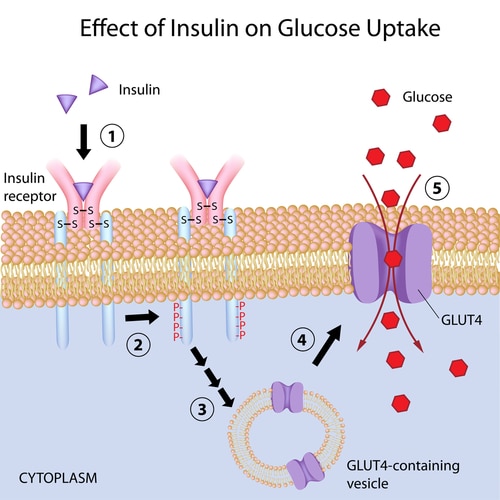
What is Insulin Resistance?
When you’re insulin resistant, your cells are less responsive to insulin, the hormone that helps cells take up glucose. As a result, your pancreas, the organ that produces insulin, has to produce more insulin to get glucose into cells. If you have insulin resistance, you have more insulin floating around in your bloodstream. This is a problem for a number of reasons. For one, high insulin levels make it easier for your body to store fat, especially visceral fat, deep belly fat that’s linked with an increased risk for heart disease.
Secondly, your pancreas has to work harder to produce more insulin when cells are insulin resistant. At some point, your pancreas may burn out and not be able to produce enough insulin to get glucose into cells. That’s when your blood sugars start rising and you cross over the threshold to type 2 diabetes. Finally, insulin resistance is linked with other health problems including heart disease, high triglycerides, and high blood pressure. It’s not a healthy state to be in.
Why Do People Become Insulin Resistant?
There is a genetic component to insulin resistance. In fact, genetics may be slightly more important than lifestyle in determining whether you become insulin resistant – but only slightly. Lifestyle plays a huge role in preventing insulin resistance and reversing it once it develops. Of the lifestyle factors that contribute to becoming insulin resistant, lack of exercise, diet, and obesity are major factors that put you at risk for insulin resistance.
Dietary Factors and Insulin Resistance
In terms of diet, you might think processed carbs and sugar are the major contributors to insulin resistance. No doubt they’re important. Rapidly-absorbed carbohydrates and sugar force your pancreas to work harder to pump out more insulin. This puts added stress on your pancreas.
There’s also some evidence that a diet high in saturated fats contributes to insulin resistance. Diets high in trans-fat have also been linked with a greater risk for insulin resistance. Another ingredient common in packaged foods that may increase your risk for insulin resistance is high-fructose corn syrup. Whether high-fructose corn syrup produces insulin resistance in human is still controversial – but why take a chance?
One study showed people who eat more saturated fat are more likely to be insulin resistant than those that ate monounsaturated fat. Monounsaturated fat is abundant in olive oil, nuts, and avocados whereas saturated fat is found mostly in meat and full-fat dairy products.
Obesity is another major risk factor for insulin resistance. Where you store your fat may also be a factor. Women who carry more of their fat in the waist and abdomen as opposed to the hips and thighs are at higher risk.
The good news? Losing weight improves insulin sensitivity. Even losing a modest amount of weight, if you’re overweight or obese, can have a major impact on how your cells respond to insulin. Weight loss doesn’t have to be dramatic to have benefits. You don’t have to be a candidate for the “Biggest Loser” to lower your health risks through weight loss.
What Role Does Exercise Play?
Inactivity is another risk factor for insulin resistance. You might think aerobic exercise is the best form of exercise for preventing insulin resistance. Aerobic exercise is beneficial because it increases insulin sensitivity, not just while you’re exercising but afterward as well. When you’re exercising, cells can take up glucose without the help of insulin. Therefore, exercise lowers blood glucose levels too. But you need resistance training too. Insulin resistance has been linked with the loss of muscle mass that occurs with aging. Resistance training helps maintain lean muscle mass for better insulin sensitivity.
One study showed a twice-a-week resistance training program significantly increased insulin sensitivity over a four-month period. Not to mention the participants developed greater upper and lower body strength.
How does resistance training reduce insulin resistance? Some research shows resistance training increases levels of a hormone called adiponectin. Adiponectin is produced by fat cells, but overweight and obese people produce less of this protein hormone. Adiponectin is a “good guy” when it comes to your health. Adiponectin increases insulin sensitivity. In addition, it has anti-inflammatory and weight loss benefits. Higher adiponectin levels have been linked with a lower risk for heart disease as well. In addition, resistance training improves insulin sensitivity by reducing body fat, especially visceral body fat, and increasing lean muscle mass.
How Do You Know if You’re Insulin Resistant?
People who are insulin resistant often have other signs and symptoms. These include:
Being Overweight
A high waist-to-hip ratio. Insulin resistant people tend to have higher levels of visceral abdominal fat.
Age greater than 40
High blood pressure
High triglyceride level (above 150 mg/dL)
Low HDL-cholesterol (under 35 mg/dL )
Sedentary lifestyle
History of polycystic ovary disease
You don’t have to have all of these signs and symptoms to be insulin resistant. Doctors may look for insulin resistance in patients by measuring an insulin level, a fasting blood sugar level or, in some cases, a glucose tolerance test.
The Bottom Line?
Insulin is a common health problem and a harbinger to other health issues. Genetics play a role in who becomes insulin resistant but lifestyle is no less important. Make sure you’re eating a diet of mainly whole foods and are doing BOTH aerobic exercise and resistance training to reduce insulin resistance and help control your body weight and composition.
References:
Diabetes Self Management. March/April 2013. ‘Insulin Resistance”
Med Sci Sports Exerc. 2006 Jul;38(7):1208-15.
Diabetes Care November 2003 vol. 26 no. 11 2977-2982.
Int J Med Sci 2007; 4(1):19-27. doi:10.7150/ijms.4.19
Clin Chim Acta. 2013 Feb 18;417:80-4.
Eur J Endocrinol. 2007 Nov;157(5):625-31.
Am J Clin Nutr November 2002 vol. 76 no. 5 911-922.
Related Articles By Cathe:
Can Normal Weight and Thin People Be Insulin Resistant?
Ingredient in Processed Foods Linked with Weight Gain and Metabolic Syndrome
How Body Weight Impacts the Risk of Developing Type 2 Diabetes
What Role Does Exercise Play in Reversing Pre-diabetes?

